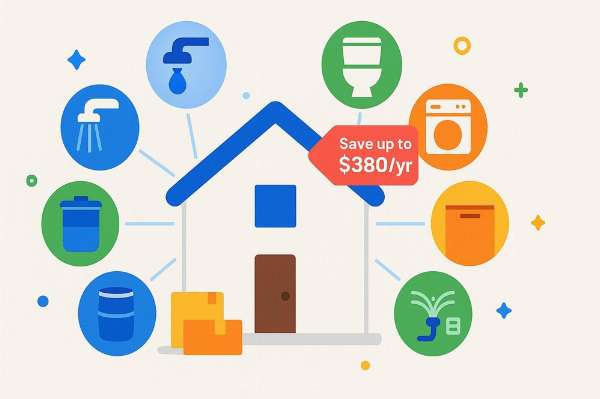- The average American family uses over 300 gallons of water daily, and the Environmental Protection Agency estimates that households waste approximately 180 gallons per week due to leaks alone.
- Simple fixes like installing low-flow showerheads and fixing leaky faucets can reduce water consumption by 20 to 60 percent without requiring major lifestyle changes.
- Water-saving strategies implemented during a move can establish efficient habits from day one and significantly lower utility costs in your new home.
Moving to a new home presents the perfect opportunity to reset your utility spending and establish water-efficient habits from the start. According to the Environmental Protection Agency's (EPA) WaterSense program, the average American family spends more than $1,000 per year on water and sewer bills, but could save $380 annually by installing water-efficient fixtures and appliances. Whether you're settling into a new house or apartment, these eight practical water-saving tips will help you conserve resources and reduce monthly expenses without sacrificing comfort or convenience.
Table of Contents
- Fix Leaks Immediately to Prevent Waste
- Install Water-Efficient Fixtures
- Adjust Your Shower Habits
- Upgrade to Smart Appliances
- Practice Outdoor Water Conservation
- Optimize Kitchen and Bathroom Usage
- Collect and Reuse Water
- Monitor Your Water Bill
- Putting Water Conservation Into Practice
Fix Leaks Immediately to Prevent Waste
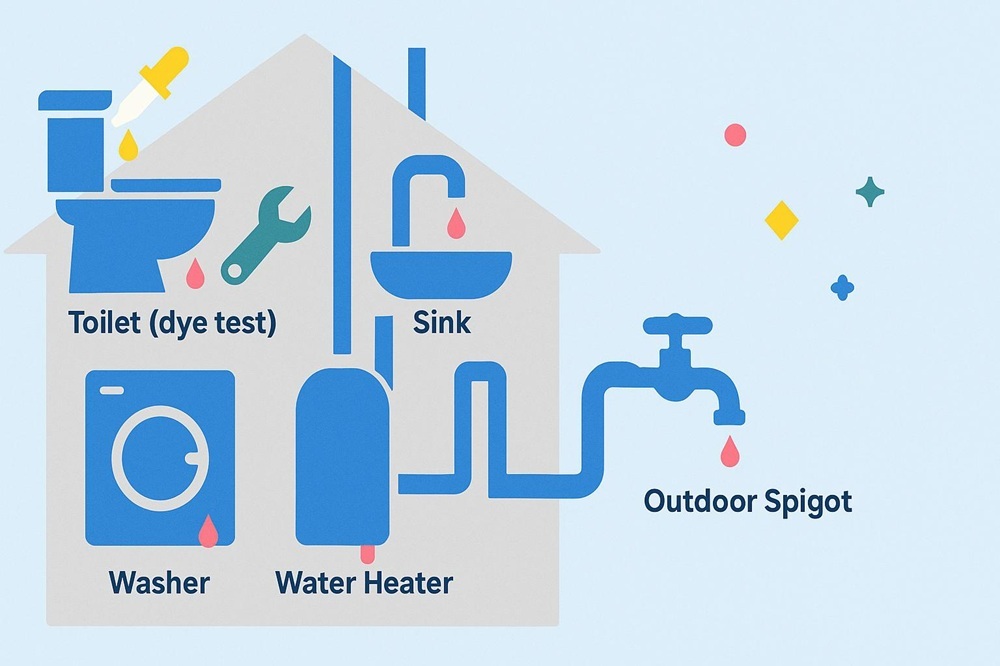
One of the most significant yet overlooked sources of water waste happens silently behind walls and under sinks. The EPA estimates that household leaks waste nearly 900 billion gallons of water annually nationwide. A single faucet dripping at one drip per second can waste more than 3,000 gallons per year, enough to fill over 180 showers.
When you first move into your new home, conduct a thorough leak inspection. Check under sinks, around toilets, behind washing machines and near water heaters. Look for moisture, water stains or mold growth that might indicate hidden leaks. A simple way to test your toilet for leaks is to add a few drops of food coloring to the tank and wait 10 minutes without flushing. If color appears in the bowl, you have a leak that's wasting water every minute.
Move-In Advantage: Many landlords and sellers are willing to fix leaks before or immediately after you move in, so document any issues during your walkthrough. |
Common Leak Locations to Inspect Focus
your inspection on high-risk areas where leaks are most likely to occur. Toilets account for nearly 30 percent of residential indoor water use, and older toilet flappers can deteriorate quickly, causing silent leaks. Faucet washers and gaskets also wear out over time, particularly in homes with hard water. Check your outdoor spigots and irrigation systems too, as these are frequently forgotten but can waste substantial amounts of water during warmer months. If you discover a leak, address it ASAP. Simple repairs like replacing a worn flapper valve cost under $10 and take just minutes to complete. More complex leaks may require professional help, but the investment pays for itself quickly through reduced water bills.
Install Water-Efficient Fixtures
Replacing outdated fixtures represents one of the most effective long-term water-saving strategies available to homeowners and renters. WaterSense-labeled products use at least 20 percent less water than standard models while maintaining performance standards. According to the EPA, if every household in America installed WaterSense-labeled fixtures, the country would save more than $18 billion in water costs annually.
Low-flow showerheads deliver satisfying water pressure while using 2 gallons per minute or less, compared to older models that use 5 gallons per minute or more. This simple switch can save a family of four up to 2,900 gallons per year. Aerators for kitchen and bathroom faucets cost just a few dollars and reduce flow rates from 2.2 gallons per minute to 1.5 gallons per minute or less without noticeably affecting functionality
Best Fixtures for Renters and Homeowners
If you're renting, focus on temporary upgrades you can take with you. Low-flow showerheads and faucet aerators screw on easily without tools and can be removed when you move out. Keep the original fixtures to reinstall before leaving. Homeowners have more flexibility to invest in high-efficiency toilets that use 1.28 gallons per flush or less, compared to older toilets that use 3.5 to 7 gallons per flush.
When shopping for water-efficient fixtures, look for the WaterSense label, which indicates the product meets EPA criteria for both efficiency and performance. Many utility companies offer rebates for purchasing qualifying fixtures, potentially reducing your upfront costs by 50 percent or more.
Rebate Reminder: Check with your local water utility before purchasing new fixtures, as many offer rebate programs that can significantly offset the cost of water-efficient upgrades. |
Adjust Your Shower Habits
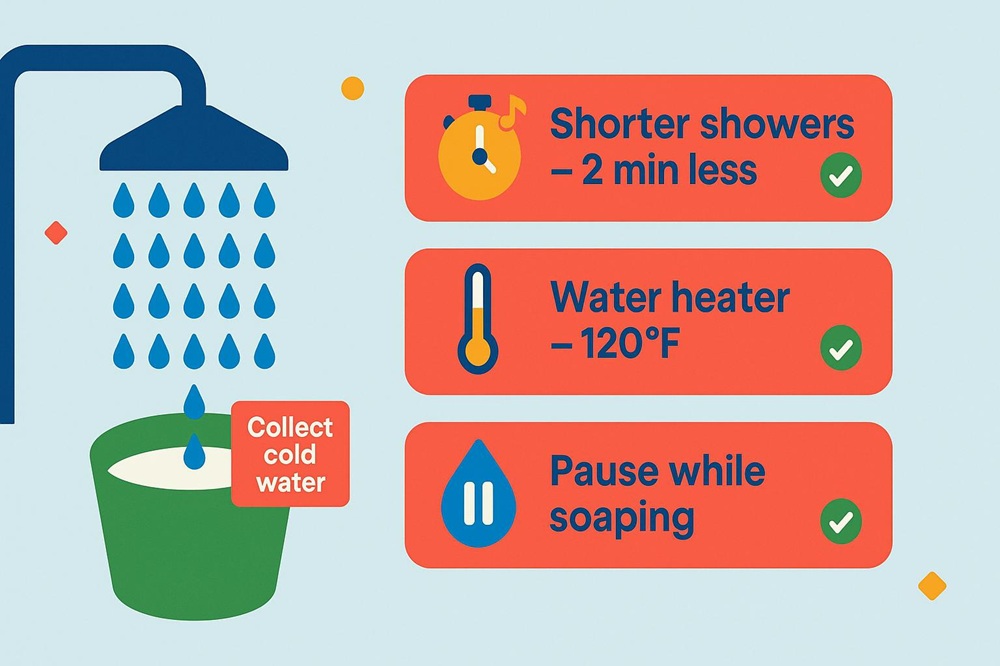
Showers account for nearly 17 percent of residential indoor water use, according to the EPA. The average American shower lasts about 8 minutes and uses approximately 17 gallons of water. Reducing your shower time by just two minutes can save up to 1,825 gallons per person annually.
Setting a timer or playing a favorite song can help you track shower duration without constantly checking the clock. Some people find that turning off the water while soaping up or shampooing can dramatically reduce consumption. Even if you only implement this technique occasionally, the savings add up over time.
Temperature and Timing Strategies
Hot water usage affects both your water and energy bills. Heating water accounts for about 18 percent of your home's energy use, according to the Department of Energy. Slightly lowering your water heater temperature to 120 degrees Fahrenheit maintains comfort while reducing energy costs. Additionally, waiting for hot water to reach your shower wastes an average of 2 to 5 gallons per use. Consider collecting this cold water in a bucket to use for watering plants or cleaning.
Establishing water-efficient shower habits when you first move in makes them feel natural rather than restrictive. Setting up utilities at your new address is an ideal time to reassess your water consumption and implement positive changes.
Upgrade to Smart Appliances
Washing machines and dishwashers represent significant water users in most homes. Older washing machines use approximately 40 gallons per load, while newer ENERGY STAR-certified models use less than 15 gallons per load. Over the course of a year, upgrading to an efficient washer can save a family of four more than 6,000 gallons of water.
If you're moving into a new home and need to purchase appliances, prioritize water efficiency alongside other features. Front-loading washers typically use less water than top-loading models and are gentler on clothes. Dishwashers actually use less water than hand washing when fully loaded, consuming as little as 3 gallons per cycle compared to the 27 gallons the average person uses when washing dishes by hand.
Maximizing Appliance Efficiency
Even if you can't immediately upgrade your appliances, you can use them more efficiently. Only run full loads in both your dishwasher and washing machine. Modern detergents work effectively in cold water, reducing both water-heating costs and energy consumption. Skip the pre-rinse cycle on your dishwasher, as modern models are designed to handle food residue without it.
When comparing appliances, check for the ENERGY STAR label and review the yellow EnergyGuide label that shows estimated annual operating costs. These tools help you calculate the long-term savings potential of different models. Some utility companies also offer rebates on efficient appliances, similar to fixture rebate programs.
Smart Shopping: Time your appliance purchases around major sales events and check manufacturer and utility rebates to maximize savings on water-efficient models. |
Practice Outdoor Water Conservation
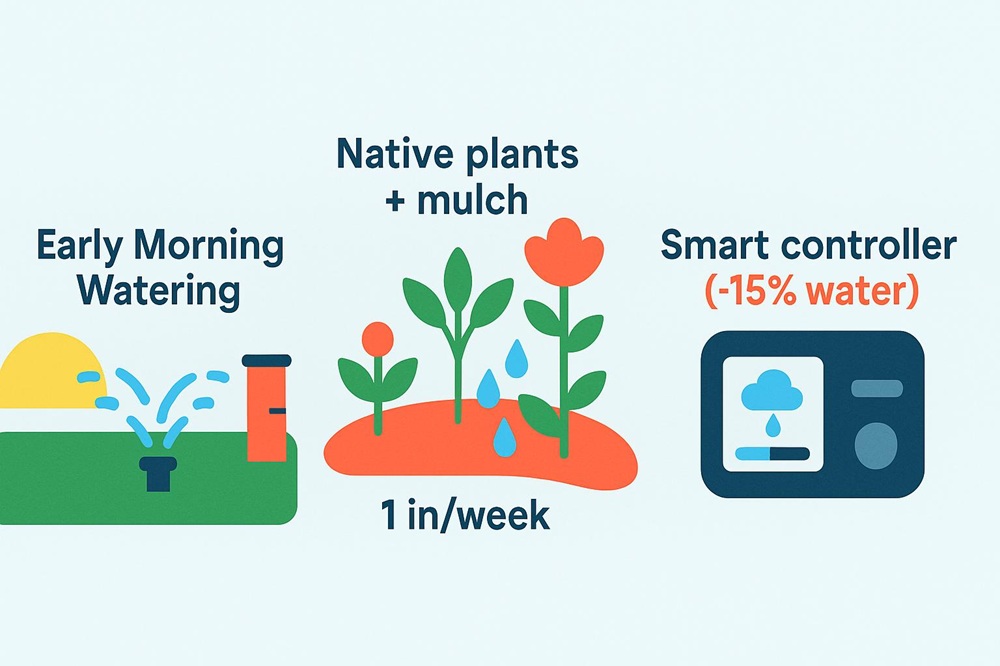
Outdoor water use accounts for nearly 30 percent of household water consumption nationally, but can be much higher in drier climates. The EPA reports that as much as 50 percent of outdoor water use goes to waste due to evaporation, wind, or runoff from overwatering. Implementing smart outdoor watering practices can reduce exterior water use by up to 50 percent.
Water your lawn and garden during early morning hours when temperatures are cooler and winds are calmer. This timing minimizes evaporation and allows water to soak into the soil before the heat of the day. Most established lawns need only 1 inch of water per week, including rainfall. Placing a rain gauge on your lawn helps you measure exactly how much water your sprinkler delivers.
Landscaping and Irrigation Techniques
Consider your landscaping choices carefully when moving to a new home. Native plants typically require less water than non-native species because they've adapted to local rainfall patterns. Grouping plants with similar water needs together and using mulch to retain soil moisture can significantly reduce irrigation requirements.
If your new home has an irrigation system, adjust the timer seasonally and inspect sprinkler heads regularly for leaks or misalignment. Smart irrigation controllers that adjust watering schedules based on weather conditions can reduce outdoor water use by 15 percent or more. Some water utilities offer rebates for installing these devices.
For those moving to areas with water restrictions or drought conditions, understanding the cost of living differences between cities includes factoring in potential water costs and conservation requirements.
Optimize Kitchen and Bathroom Usage
Small behavioral changes in your daily kitchen and bathroom routines can generate substantial water savings without requiring any financial investment. The key is developing efficient habits that become second nature over time.
In the kitchen, avoid running water continuously while washing dishes, rinsing produce or thawing frozen foods. Fill one sink basin or a large bowl with wash water and another with rinse water instead. When rinsing vegetables, use a bowl and then repurpose that water for houseplants. Defrost frozen items in the refrigerator overnight rather than under running water.
Bathroom Water Conservation Techniques
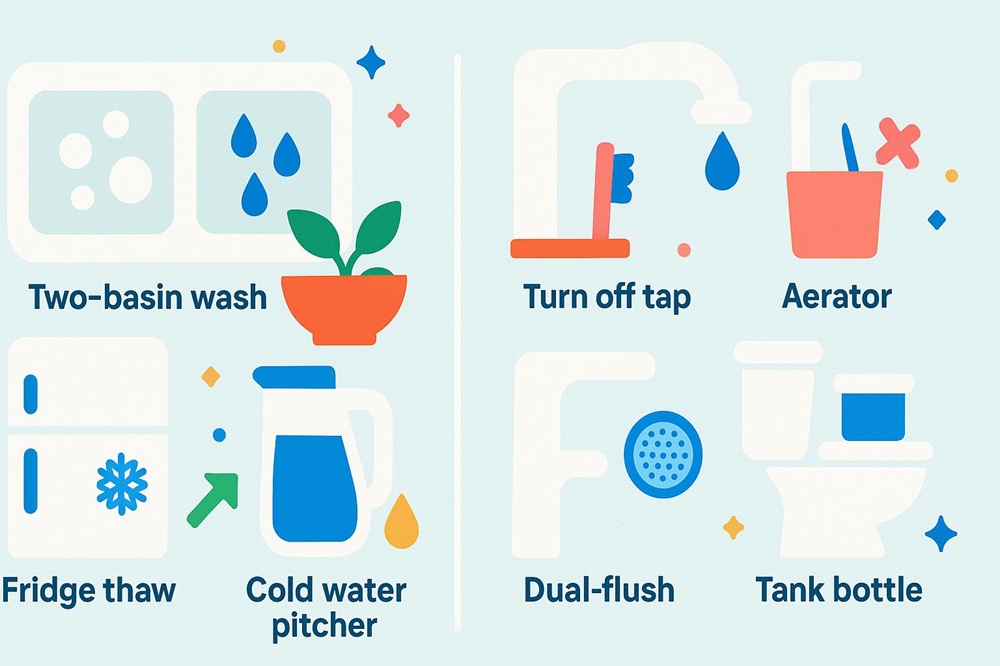
Turn off the faucet while brushing your teeth, washing your face or shaving. This simple action saves approximately 8 gallons of water per day per person. Install a faucet aerator if your sink doesn't already have one to reduce flow without affecting functionality. Keep a pitcher of drinking water in the refrigerator instead of running the tap until the water turns cold.
Consider upgrading to dual-flush toilets that offer different flush volumes for liquid and solid waste. If replacement isn't an option, placing a weighted plastic bottle in the toilet tank can reduce the amount of water used per flush. Just make sure this doesn't interfere with the flushing mechanism.
As you're settling into your new home during the first week, establish these water-saving routines so they become habits rather than chores.
Collect and Reuse Water
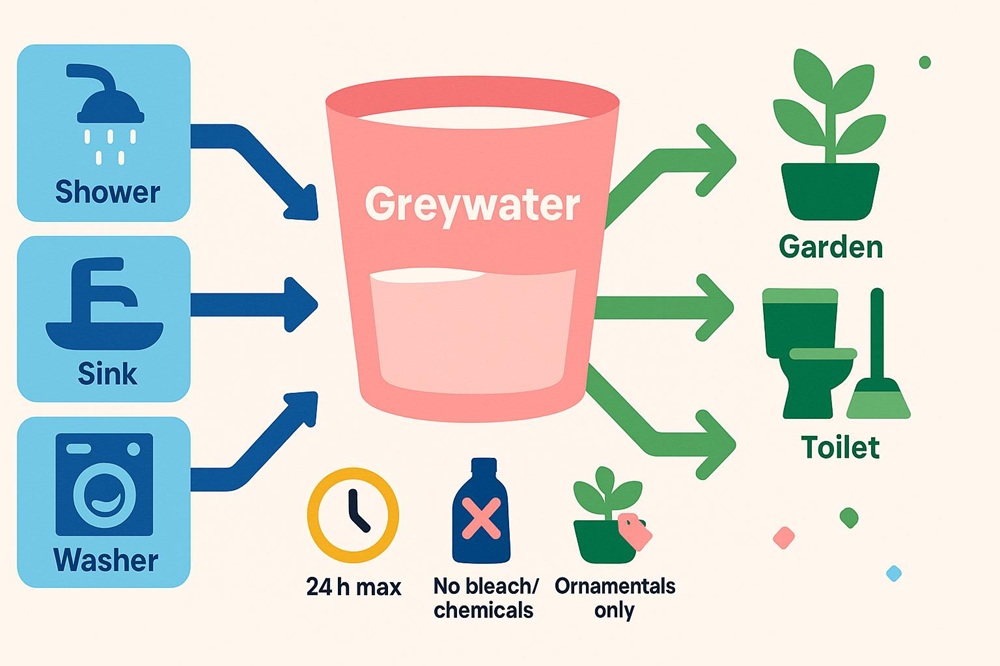
Many households send perfectly usable water down the drain without realizing it can serve other purposes. Collecting and reusing greywater represents an intermediate conservation strategy that can significantly reduce overall water consumption.
Place a bucket in your shower to catch water while it heats up or while you're soaping and shampooing. This collected water works perfectly for watering outdoor plants, flushing toilets or cleaning floors. Similarly, catch the water from rinsing fruits and vegetables, or from boiling pasta, and use it to water houseplants once it has cooled.
Safe Greywater Practices
When reusing water, follow basic safety guidelines to ensure a safe and healthy environment. Use only water containing mild, biodegradable soap on ornamental plants, not on edible plants. Don't store greywater for more than 24 hours, as bacteria can multiply. Never reuse water that has come into contact with raw meat, harsh chemicals or cleaning products containing bleach.
Some homeowners install more sophisticated greywater systems that redirect water from washing machines, showers and bathroom sinks to irrigation systems. These systems require proper installation and must comply with local building codes, but can reduce household water use by up to 30 percent in some cases.
Simple Start: Begin with simple greywater collection practices, such as shower buckets, before considering more complex systems that require installation and maintenance. |
Monitor Your Water Bill
Tracking your water consumption helps you identify usage patterns, detect problems early and measure the effectiveness of your conservation efforts. Most water bills include historical usage data that lets you compare current consumption to previous months or the same period last year.
Establish a baseline during your first month or two in your new home. Note your daily average water use by dividing your monthly usage by the number of days in the billing period. The EPA states that the average American uses 82 gallons per day, so a family of four should expect around 9,840 gallons per month. If your usage significantly exceeds this benchmark, investigate potential causes like leaks or inefficient fixtures.
Using Technology to Track Consumption
Many modern water meters feature automatic meter reading (AMR) or advanced metering infrastructure (AMI), which provide detailed consumption data. Some utility companies offer online portals or smartphone apps that let you monitor daily usage, set conservation goals and receive alerts about unusual consumption patterns that may indicate leaks.
If your utility doesn't offer digital tracking, manually record your meter reading weekly. Unexpected spikes often indicate problems requiring immediate attention. Addressing these issues quickly prevents water waste and avoids surprisingly high bills.
When you're setting up utilities at your new address, ask your water provider about available monitoring tools, budget billing options and conservation programs that might benefit your household.
Putting Water Conservation Into Practice
Implementing these eight water-saving strategies doesn't require drastic lifestyle changes or expensive renovations. The most effective approach is to start with simple, low-cost behavioral changes, such as fixing leaks and adjusting daily habits, then gradually incorporate fixture upgrades and appliance replacements as your budget allows. Moving to a new home provides the ideal opportunity to establish water-efficient practices from day one, potentially saving your household hundreds of dollars annually while reducing environmental impact.
Frequently Asked Questions About Saving Water
How much money can I realistically save by implementing these water-saving tips?
The EPA estimates that the average household can save $350 annually through water-efficient fixtures alone. When you combine fixture upgrades with behavioral changes like shorter showers and fixing leaks, total savings can exceed $600 per year, depending on your current usage patterns and local water rates. Households in areas with higher water costs or those with particularly wasteful habits may see even greater savings.
Are low-flow fixtures as effective as standard fixtures?
Yes, modern low-flow fixtures are specifically designed to maintain performance while using less water. WaterSense-labeled products must meet EPA performance standards, meaning they work just as well as standard fixtures despite using 20 percent less water. Many users report no noticeable difference in their experience after switching to low-flow showerheads and faucets.
What's the fastest way to identify if I have a water leak?
Check your water meter before bedtime when no water is being used. Record the reading, then check it again in the morning before anyone uses water. If the meter has moved, you likely have a leak. For toilets specifically, add food coloring to the tank and wait 10 minutes without flushing. If color appears in the bowl, the toilet is leaking.
Should I run my dishwasher if it's not completely full?
No, wait until your dishwasher is full before running it. Modern dishwashers use the same amount of water regardless of how many dishes they contain, so partial loads waste both water and energy. If you need certain dishes sooner, hand-wash just those items rather than running a partial load.
Do water-saving habits really make a difference for the environment?
Absolutely. Household water conservation reduces the energy required to pump, heat and treat water, which decreases greenhouse gas emissions. It also helps preserve freshwater resources for ecosystems and future generations. According to the EPA, if just one percent of American homes replaced old fixtures with WaterSense models, the country would save more than 80 billion gallons of water annually.
How often should I replace water-efficient fixtures?
Most water-efficient fixtures last 10 to 15 years with proper maintenance. Faucet aerators and showerheads may need to be replaced sooner if mineral deposits reduce their efficiency, typically every five to seven years in areas with hard water. Toilet flappers should be inspected annually and replaced every three to five years to prevent leaks.



